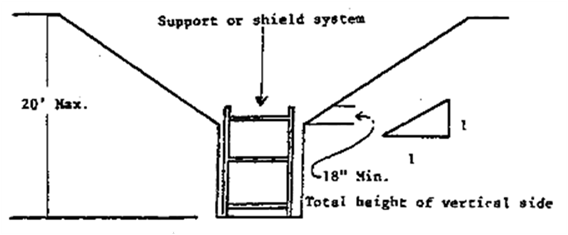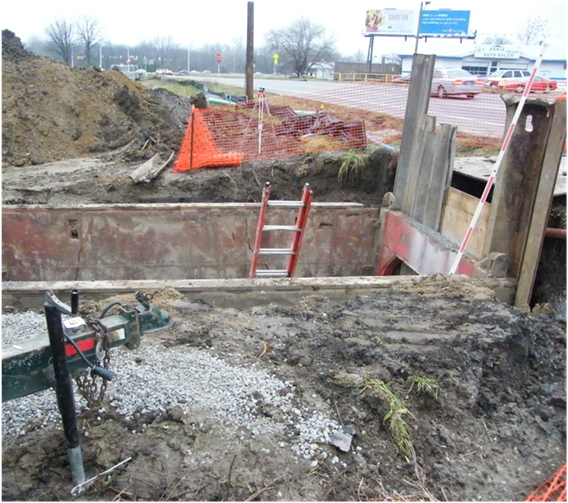Part 2- “Trench Shields the 18 Inch Rule”
By: Matt McCreery
The Occupational Safety and Health Administration (OSHA) has received thousands of questions and requests for clarification about their occupational health and safety standards from employers, individuals, unions, and other organizations throughout the years. When OSHA responds to these questions, they typically do so through a Letter of Interpretation. These letters are posted on the OSHA website, and address many topics; they are a great resource for employers because they may answer your question(s) about a particular standard or topic. However, be aware that the letters only address the specific question asked, and may not apply to your exact situation. Also, the letters are strictly interpretations issues by OSHA, and do not alter the meaning of the actual OSHA standards. The intent of this newsletter series will be to provide insight into some of the more unique interpretations provided by OSHA.
Some of you may be familiar with the interpretation letter we will be discussing but in case you are not, I will provide a quick synopsis of the letter and the affected standards. On an interpretation letter dated August 20, 2000 Mr. Michael W. West the Director of Engineering and Materials Management for Efficiency Production, Inc., presented the following request to clarify the 29 CFR 1926.650 Subpart P from OSHA in relation to the 18 inch requirement when the top of the shield is above ground level.
The excavation standard is codified in 29 CFR 1926.650 (subpart P). The standard allows several options for protecting employees in excavations. One of those options involves complying with measures depicted in Appendix B. Some of the drawings in B-1.1 through B-1.3 illustrate the placement of trench shields in soil types A through C, respectively. Three of the drawings ([B-1.1f], "Unsupported Vertically Sided Lower Portion — Maximum 12 Feet in Depth";[B-1.2d], "Multiple Bench"; and [B-1.3b], "Simple Slope") show the required use of a trench shield where the excavation walls slope down from the top and then become vertical (see sample drawing below).
Grade (Ground Level)

Each drawing shows excavations whose depth is greater than the height of the shield itself, with the tops of the shields below grade. Specifically, the trench shield extends 18 inches (0.45 m) above the vertical part of the walls, but is below the top of the trench. Therefore, where the top of the shield is below grade, it must extend a minimum of 18 inches above the vertical part of the wall. You ask if this 18 inch requirement applies where that would put the top of the shield above ground level.
The answer is no; the standard does not require trench shields to extend above grade (that is, above the top level of the excavation). Your letter refers to some of the measures to protect employees in excavations set out in subpart P, such as the requirement that spoil piles are to be maintained at least 2 feet (.61 m) from the edge of an excavation [§1926.651(j)(2)]. You note that a competent person is to be responsible for ensuring site safety for the excavation. [Our excavation standards refer to duties of a competent person in §§1926.651(c)(1)(i), 1926.651(h)(2) and 1926.651(h)(3), and 1926.651(k)(1) and 1926.651(k)(2) and 1926.652(a)(1)(ii) and 1926.652(d)(3).] Recognizing the need for those (and other) appropriate protective measures, you assert that the 18-inch distance in figures B-1.1 through B-1.3 is "obviously intended to prevent materials from rolling into the trench" and that when the tops of trench shields "are at ground level, the 18-inch distance is not required." That is correct; OSHA's excavation standards do not require that the top of a trench shield at ground level must be at least 18 inches (0.45 m) above grade in the situation you describe.
So in layman’s terms, if you as a Safety Director or Competent Person on-site anticipate material or debris to potentially roll into the trench or trench box then application of the 18 inch rule would be required. Take the picture below for example:

The pictured example per OSHA would be compliant because it is reasonable to assume that debris would not and could not roll into the trench system. Had this system been set even a couple more feet below grade then the 18 inch trench shield rule would apply. This 18 inch rule is often used incorrectly across the board for all trench box systems and misunderstood by safety professionals and management alike.
Related Topics: OSHA Letter of Interpretation, Safety Articles, Monthly Safety Topics